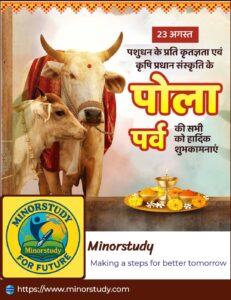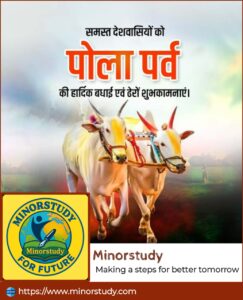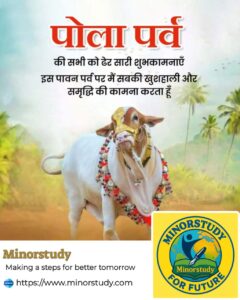🐂 Introduction: What Is Pola Mahaparv?
In the vast cultural land of India, every festival tells a story — of gratitude, faith, and the deep bond between nature and human life. One such beautiful and unique festival is Pola Mahaparv (or simply “Pola”). Celebrated mostly in Maharashtra, Chhattisgarh, Madhya Pradesh, parts of Uttar Pradesh, Telangana, and rural India, this festival is dedicated to bulls and oxen, the silent partners in India’s agricultural journey.
- 📜 History of Pola Mahaparv
- 📅 Timeline & Calendar Date
- 🌾 How Is Pola Mahaparv Celebrated?
- 🐂 1. Bathing & Decorating Bulls
- 🌿 2. Worship & Aarti
- 🪵 3. Nagarchi Ceremony
- 🎉 4. Processions & Parades
- 🧒 5. Children’s Mini-Pola
- 📸 Pola Mahaparv – A Visual Glimpse
- 🧠 Interesting Facts About Pola Mahaparv
- 🎯 Significance of Pola Mahaparv
- 💌 Wishing on Pola Mahaparv (Greeting Messages)
- 📌 Important Points to Remember
- 🗓️ Observance in Different States
- 🧭 Why Is Pola Important in Our Daily Life?
- 📖 FAQs About Pola Mahaparv
- ❓ Q1. Who celebrates Pola Mahaparv?
- ❓ Q2. Why is it called “Pola”?
- ❓ Q3. Is Pola a public holiday?
- ❓ Q4. Are only bulls worshipped?
- ❓ Q5. Do urban people celebrate Pola?
- ⭐ Review Section: What People Say About Pola Mahaparv
- ✅ Conclusion: The Daily Life Impact of Pola Mahaparv
Pola Mahaparv is not just a “festival” — it’s an emotion, a thank-you note from farmers to their cattle. It reflects a human-centric behavior of love, duty, and interdependence between humans and animals.
📜 History of Pola Mahaparv
The origin of Pola is deeply rooted in agrarian culture and Sanatan Dharma (Hindu traditions). In ancient India, bulls and oxen were not just animals — they were considered family members. They ploughed the fields, transported goods, and sustained rural economies.
Historically:
Pola was observed post-monsoon, around Shravan Amavasya (New Moon of the Shravan month, usually August).
It is believed that Rishi Parashurama blessed the bull for its strength and loyalty.
The festival is linked to the Puranic story of Lord Krishna where he used bulls to protect crops.
In Maharashtra, Chhattisgarh, and Madhya Pradesh, the festival dates back over 1000 years, recorded in folk literature, oral stories, and copper plate inscriptions.
📅 Timeline & Calendar Date
| Year | Pola Mahaparv Date | Lunar Month | Tithi |
|---|---|---|---|
| 2023 | 14 August | Shravan | Amavasya |
| 2024 | 4 September | Shravan | Amavasya |
| 2025 | 24 August | Shravan | Amavasya |
🕉️ When is Pola?
Pola is celebrated on Shravan Amavasya — the new moon day of the Shravan month (July-August), according to the Hindu lunar calendar.
🌾 How Is Pola Mahaparv Celebrated?
The celebration of Pola is a colorful, joyous, and deeply symbolic event.
🐂 1. Bathing & Decorating Bulls
Bulls and oxen are bathed with turmeric water.
Their horns are painted with bright colors.
They are decorated with garlands, bells, embroidered clothes, and anklets.
🌿 2. Worship & Aarti
Farmers worship their bulls by applying kumkum, haldi, and offering jaggery, rice, and flowers.
A lamp (diya) is lit and an aarti is performed.
🪵 3. Nagarchi Ceremony
A wooden pillar (called Nagarchi) is worshipped symbolizing strength.
Bulls are made to run over it to show their power and loyalty.
🎉 4. Processions & Parades
Decorated bulls are taken out in village processions.
Folk songs, dhol-taasha (drums), and traditional dances fill the air.
🧒 5. Children’s Mini-Pola
On the day before Pola, children celebrate ‘Bail Pola’ (Toy Pola).
They decorate wooden bull toys and take them house to house.
📸 Pola Mahaparv – A Visual Glimpse
Below are some traditional and heart-warming visuals of the festival: decorated bulls, rural processions, and children’s mini-Pola.
🧠 Interesting Facts About Pola Mahaparv
Here are 7 powerful facts that make this festival truly unique:
| # | Fact | Why It Matters |
|---|---|---|
| 1 | Pola is one of the few festivals in the world dedicated to animals | Shows compassion and gratitude. |
| 2 | Celebrated mostly by farmers and agrarian communities | Highlights India’s rural cultural richness. |
| 3 | Bulls are given a holiday from work | Symbol of respect for hard-working animals. |
| 4 | Kids celebrate a separate ‘Bail Pola’ | Teaches values of care and tradition early. |
| 5 | The horns are painted with natural colors | Eco-friendly and traditional art. |
| 6 | Pola strengthens village unity and harmony | Families come together. |
| 7 | Pola marks the end of sowing season | A spiritual pause and thanksgiving. |
🎯 Significance of Pola Mahaparv
🐃 Spiritual Significance
Bulls are considered Nandi, the vehicle of Lord Shiva.
Worshipping bulls on Pola is considered auspicious and brings blessings for a good harvest.
🌱 Agricultural Significance
Farmers thank their bulls for helping them plough the fields.
It is seen as a gratitude festival in rural India.
👨👩👧👦 Social & Cultural Significance
It brings villagers, families, and communities together.
Teaches compassion, patience, and non-violence.
Strengthens the bond between humans and nature.
💌 Wishing on Pola Mahaparv (Greeting Messages)
Here are some heart-warming wishes you can share on this day:
🌾 “Wishing you and your family a blessed Pola Mahaparv! May your life be filled with gratitude, strength, and good harvest.”
🐂 “Happy Pola! Let’s honor the silent companions of our fields and thank them for their tireless service.”
🌻 “May the blessings of Nandi and Mother Earth be with you on this sacred Pola Mahaparv.”
💛 “Celebrate compassion. Celebrate Pola. Happy Pola Mahaparv!”
📌 Important Points to Remember
📍 Celebrated on Shravan Amavasya.
🐃 Dedicated to bulls and oxen.
🧒 Children celebrate toy-Pola.
🕯️ Includes worship, aarti, processions.
🌾 Symbolizes end of sowing season.
🕉️ Has deep spiritual meaning in Hindu culture.
🫂 Strengthens social bonds in villages.
🗓️ Observance in Different States
| State | Local Name | Unique Customs |
|---|---|---|
| Maharashtra | Bail Pola | Grand village processions |
| Chhattisgarh | Pola | Wooden bull toy parade by children |
| Madhya Pradesh | Pola | Traditional bull races |
| Telangana | Pola / Polala Amavasya | Women worship Goddess Polamma |
| Uttar Pradesh | Pola | Rural folk rituals and bull worship |
🧭 Why Is Pola Important in Our Daily Life?
Even if you are not a farmer, Pola teaches life lessons we all can embrace:
Gratitude – Thank those who help us silently.
Non-violence – Respect and protect animals.
Simplicity – Celebrate life without extravagance.
Sustainability – Use natural colors, eco-friendly rituals.
Community bonding – Reconnect with roots and culture.
📖 FAQs About Pola Mahaparv
❓ Q1. Who celebrates Pola Mahaparv?
Ans: Mainly rural communities in Maharashtra, Chhattisgarh, Madhya Pradesh, and parts of central India.
❓ Q2. Why is it called “Pola”?
Ans: The term “Pola” is believed to be derived from “Pol” meaning “bull” in local dialects.
❓ Q3. Is Pola a public holiday?
Ans: In many rural districts, yes. Schools and offices in villages often remain closed.
❓ Q4. Are only bulls worshipped?
Ans: Primarily yes, but sometimes cows, buffaloes, and even ploughs are symbolically honored.
❓ Q5. Do urban people celebrate Pola?
Ans: Rarely. It’s mostly rural, but urban people with agrarian roots may still observe it symbolically.
⭐ Review Section: What People Say About Pola Mahaparv
🌟 “As a city-born child, I had never seen anything like Pola. Visiting my grandparents’ village opened my eyes to how deeply people respect animals. It’s a festival of love.” — Aarohi Deshmukh, Pune
🌟 “Pola is more than a festival; it’s a lesson in gratitude. I love decorating my bull and singing folk songs with my neighbors.” — Mahadev Yadav, Chhattisgarh
🌟 “My kids love mini-Pola! They decorate wooden bulls, and it teaches them compassion in such a fun way.” — Sunita Verma, Madhya Pradesh
✅ Conclusion: The Daily Life Impact of Pola Mahaparv
Pola Mahaparv may seem like a rural ritual, but in truth, it is a universal human value system in action. It teaches us:
To honor labor, whether human or animal.
To give back, even if the helper never asked.
To live in harmony with nature.
In our fast-paced world, Pola reminds us to pause and thank the silent contributors in our lives — be it a farmer, a parent, a teacher, or an animal. Whether you celebrate it or not, the values of Pola — gratitude, humility, and connection — are worth celebrating every day.
🔖 Keywords to Remember
Pola Mahaparv
Bull Festival India
Shravan Amavasya Festival
Bail Pola
Animal Worship Festival
💠 Final Thought:
In a world chasing progress, Pola whispers — “Don’t forget to thank the ones who helped you plough your path.”













